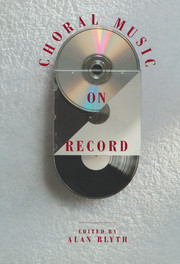Book contents
- Frontmatter
- Contents
- Preface
- Monteverdi: Vespers (1610)
- J.S. Bach: St John Passion
- J.S. Bach: St Matthew Passion
- J.S. Bach: Mass in B Minor
- Handel: Messiah
- Mozart: Requiem Mass
- Haydn: The Creation
- Haydn: The Seasons
- Beethoven: Missa Solemnis
- Mendelssohn: Elijah
- Rossini: Stabat mater Petite messe solennelle
- Berlioz: Grande Messe des Morts Te Deum L'Enfance du Christ
- Verdi: Requiem Mass
- Brahms: A German Requiem
- Fauré: Requiem
- Elgar: The Dream of Gerontius
- Walton: Belshazzar's Feast, Tippett: A Child of Our Time, Britten: War Requiem
- Stravinsky: The Wedding Symphony of Psalms
- Janáček: Glagolitic Mass
- Discographies
- Index
Fauré: Requiem
Published online by Cambridge University Press: 02 December 2009
- Frontmatter
- Contents
- Preface
- Monteverdi: Vespers (1610)
- J.S. Bach: St John Passion
- J.S. Bach: St Matthew Passion
- J.S. Bach: Mass in B Minor
- Handel: Messiah
- Mozart: Requiem Mass
- Haydn: The Creation
- Haydn: The Seasons
- Beethoven: Missa Solemnis
- Mendelssohn: Elijah
- Rossini: Stabat mater Petite messe solennelle
- Berlioz: Grande Messe des Morts Te Deum L'Enfance du Christ
- Verdi: Requiem Mass
- Brahms: A German Requiem
- Fauré: Requiem
- Elgar: The Dream of Gerontius
- Walton: Belshazzar's Feast, Tippett: A Child of Our Time, Britten: War Requiem
- Stravinsky: The Wedding Symphony of Psalms
- Janáček: Glagolitic Mass
- Discographies
- Index
Summary
The published text of Fauré's Requiem is a strange and contradictory document. On paper the work looks as though it is scored for a standard orchestra, but closer inspection reveals how very curiously used the instruments are. There is not a single bar for full orchestra. The violins are undivided into the customary firsts and seconds, they play in only four of the seven movements and often do no more than double one of the viola lines (Fauré suggested that the viola parts could be enriched by urging some of the better violinists to switch to violas during the violin-less movements). Flutes and clarinets (always doubling strings or organ) are heard only in the Pie Jesu, the second clarinet for less than four bars; timpani and trombones (doubling the horns in all but eight bars) appear only in the Libera me. The woodwind, in particular, are not so much restrainedly as invisibly used. The question of how this anomalous score should be performed can hardly be discussed without considering how it came into existence.
Fauré began writing the Requiem in 1887 and its first version was ready in time for the funeral of a certain M. le Soufaché at the church of the Madeleine in Paris, where Fauré was choirmaster, on 16 January 1888. He worked unusually fast, possibly under the impact of the illness and death of his mother: the manuscript of the Agnus Dei is dated 6 January 1888, less than a week after Hélène Fauré died, that of the Sanctus three days later.
- Type
- Chapter
- Information
- Choral Music on Record , pp. 215 - 226Publisher: Cambridge University PressPrint publication year: 1991

